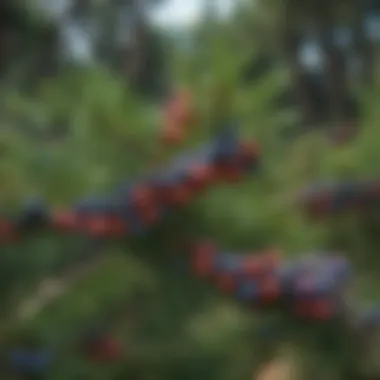Unveiling the Enchanting World of Juniper Shrubs: An In-Depth Exploration


Evergreen Trees Species
Juniper shrubs, often revered for their resilience and ornamental beauty, signify a prominent presence in the natural landscape. As evergreen plants, their enduring foliage provides year-round greenery, making them vital components of ecosystems across various climates. Diving deep into the realm of juniper shrubs unveils a diverse array of species that populate American forests. These species exhibit distinct features, from the stately Eastern Red Cedar to the aromatic Western Juniper, enriching the biodiversity of their surroundings.
Cultivation Practices and Environmental Impact
Cultivating juniper shrubs not only enhances the aesthetic appeal of gardens but also offers ecological benefits. From influencing soil stability to providing shelter and sustenance for wildlife, these shrubs play a pivotal role in ecosystem dynamics. By understanding their growth requirements and propagation methods, gardeners and forestry professionals can cultivate junipers sustainably, integrating them into green spaces effectively. Furthermore, exploring their impact on air quality, water runoff, and carbon sequestration underscores the significance of incorporating juniper shrubs into landscape management practices.
Conservation Strategies and Forestry Management
The conservation of juniper shrubs entails adopting proactive measures to safeguard their populations and their associated ecosystems. Through sustainable land management practices and restoration initiatives, stakeholders can mitigate the threats posed by habitat degradation and deforestation. Conserving juniper species not only preserves biodiversity but also supports the overall health of forests and adjacent habitats. By implementing conservation strategies like controlled burning, reforestation programs, and wildlife habitat preservation, forest management can achieve a harmonious balance between human activities and environmental protection.
Ecological Significance and Biodiversity Conservation
Juniper shrubs exemplify the interconnectedness of species within ecosystems, contributing to biodiversity and habitat resilience. Their ecological significance extends beyond their physical presence to encompass the intricate web of relationships they foster with other flora and fauna. Recognizing the role of junipers in supporting wildlife habitat, regulating microclimates, and aiding soil health underscores their irreplaceable value in ecological conservation efforts. By prioritizing biodiversity conservation and habitat restoration, forestry professionals can advocate for the sustainable management of juniper populations and promote the preservation of their associated ecosystems.
Practical Utilization and Cultural Appreciation
In addition to their ecological benefits, juniper shrubs hold cultural significance and practical utilities that span culinary, medicinal, and craft-making domains. From the aromatic cones utilized in traditional medicine to the fragrant wood employed in woodworking, juniper species offer a treasure trove of practical applications. Exploring their diverse uses not only showcases the versatility of these shrubs but also highlights the longstanding cultural associations that have shaped human interactions with junipers throughout history. By appreciating their multifaceted role in both ecological and cultural contexts, enthusiasts can deepen their connection to these resilient and revered plants.
Introduction to Juniper Shrubs
In this comprehensive guide titled 'Exploring the Beauty of Juniper Shrubs,' delving into the essence of juniper shrubs serves as a pivotal starting point. The significance of understanding juniper shrubs lies in their multifaceted nature, offering a plethora of insights for nature enthusiasts, gardeners, and forestry professionals. Unveiling the diverse array of juniper species, their ecological importance, and cultivation practices, this guide stands as a beacon of knowledge for those intrigued by the wonders of nature.
Defining Juniper Shrubs
Botanical Overview
Exploring the botanical overview of juniper shrubs unveils intricate details crucial to understanding these botanical wonders. From their taxonomic classification to anatomical features, each aspect contributes to the allure of juniper shrubs in ecosystems worldwide. The juniper's botanical overview serves as a cornerstone in botany studies, shedding light on its reproductive strategies, growth patterns, and evolutionary adaptations that make it a staple choice for ecological enthusiasts. Understanding the botanical overview of junipers is essential for appreciating their varied forms, flavors, and medicinal properties, making them a popular choice for this guide.
Physical Characteristics
The physical characteristics of juniper shrubs unravel a tapestry of diverse traits that distinguish them in the plant kingdom. Their evergreen foliage, needle-like leaves, and berry-like cones exemplify the resilience and adaptability of junipers in various climates. The visual appeal of their spiraled branches, textured bark, and sturdy structure enhances their ornamental value in gardens and landscapes. However, these physical characteristics also pose challenges such as susceptibility to certain pests and diseases, requiring attentive care and maintenance to thrive in different environments.
Historical Significance
Role in Traditional Medicine
Juniper shrubs have played a pivotal role in traditional medicine practices, exemplifying their historical significance in human wellness. The juniper's therapeutic properties have been harnessed for centuries to alleviate various ailments, ranging from digestive issues to skin ailments. Their aromatic branches, berries, and essential oils have found applications in herbal remedies and aromatherapy, underlining their enduring appeal in holistic healing practices. Understanding the role of junipers in traditional medicine offers a profound insight into their cultural and medicinal significance for generations past.
Cultural Symbolism
The cultural symbolism surrounding juniper shrubs transcends mere botanical appreciation, delving into the realms of folklore, spirituality, and societal beliefs. Junipers have been revered as symbols of protection, purification, and prosperity across diverse cultures, symbolizing resilience, wisdom, and longevity. Their presence in rituals, ceremonies, and sacred spaces underscores their symbolic importance in cultural heritage and collective consciousness. Exploring the cultural symbolism of juniper shrubs enriches our understanding of their intrinsic connection to human societies and beliefs, making them a compelling topic for exploration in this guide.


Diversity of Juniper Species
In this comprehensive guide exploring the beauty of juniper shrubs, the diversity of juniper species takes center stage, shedding light on the intricate world of these remarkable plants. Delving into the various types of junipers not only enhances our understanding of their genetic makeup but also offers insights into their different characteristics and uses. Understanding the diversity of juniper species is vital for gardeners, foresters, and nature enthusiasts as it provides a platform for selecting the most suitable varieties for specific purposes. By exploring the unique features and attributes of each juniper species, readers can appreciate the rich tapestry of the plant genus and harness its full potential in landscaping, medicine, or other applications.
Common Juniper Varieties
Juniperus communis
Juniperus communis, a prominent member of the juniper family, plays a significant role in this article by exemplifying the resilience and adaptability of juniper species. Known for its hardiness and versatility, Juniperus communis thrives in various climatic conditions, making it a popular choice for landscape designers and conservationists. Its key characteristic lies in its ability to withstand harsh environments and its contribution to biodiversity conservation. The unique feature of Juniperus communis lies in its berry production, which is not only aesthetically pleasing but also serves as a vital food source for wildlife. While Juniperus communis offers numerous benefits in terms of habitat restoration and medicinal use, some considerations include its potential invasiveness in certain regions and the need for controlled management to prevent overgrowth.
Juniperus virginiana
Another noteworthy juniper variety, Juniperus virginiana, enriches the exploration of juniper species diversification in this guide. Renowned for its aromatic wood and foliage, Juniperus virginiana adds a distinctive charm to landscapes and garden settings. Its key characteristic revolves around its fragrant red heartwood, prized for its durability and insect-repellent properties. The unique feature of Juniperus virginiana is its role in traditional practices, such as crafting cedarwood products, essential oils, and herbal remedies. While Juniperus virginiana offers advantages in terms of pest resistance and ornamental value, potential drawbacks include slow growth rates and specific soil requirements that must be considered for successful cultivation.
Rare and Exotic Junipers
Juniperus rigida
Among the rare and exotic junipers, Juniperus rigida stands out for its distinctive appearance and characteristics, making it a valuable addition to this article. The specific aspect of Juniperus rigida lies in its needle-shaped leaves and upright growth habit, creating a striking visual appeal in gardens and natural landscapes. Its key characteristic includes drought tolerance and adaptability to rocky terrains, enhancing its suitability for xeriscaping and erosion control projects. The unique feature of Juniperus rigida is its bluish-gray foliage, adding a touch of elegance to outdoor spaces. While Juniperus rigida offers advantages in terms of low maintenance and wildlife support, potential disadvantages may include susceptibility to certain pests and diseases under specific conditions.
Juniperus procumbens
Similarly, Juniperus procumbens captivates attention as an exotic juniper species, contributing to the exploration of juniper diversity in this guide. Known for its prostrate growth habit and cascading branches, Juniperus procumbens brings a cascading effect to garden designs, rockeries, and terraces. Its key characteristic lies in its ability to trail or cascade gracefully, creating dynamic visual interest in vertical or horizontal spaces. The unique feature of Juniperus procumbens is its rich green foliage and red-brown berries, enhancing its ornamental value and attracting wildlife. While Juniperus procumbens offers advantages in terms of ground cover and erosion control, potential disadvantages may include vulnerability to root rot in poorly drained soils and the need for occasional pruning to maintain shape and vigor.
Ecological Importance of Junipers
Junipers hold a critical role in our ecosystem, contributing significantly to biodiversity and environmental balance. Their presence not only enriches the landscape but also supports various wildlife species. The intricate relationship between junipers and their environment showcases a harmonious coexistence that underscores the adaptability and resilience of these shrubs. By exploring the ecological impact of junipers, we gain a deeper appreciation for their role in sustaining the natural world.
Habitat and Distribution
Adaptation to Various Climates:
Junipers exhibit remarkable adaptability to diverse climatic conditions, making them versatile and resilient plants. Their ability to thrive in harsh, arid environments as well as temperate regions highlights their exceptional hardiness. This unique characteristic equips junipers to withstand extreme temperatures and challenging soil conditions, making them a preferred choice for landscapes that demand rugged and low-maintenance greenery. Understanding the intricacies of junipers' adaptation to various climates sheds light on their capacity to flourish in a wide range of settings, making them a valuable addition to ecological systems.
Global Distribution Patterns:
Examining the global distribution patterns of junipers reveals a fascinating geographical spread that encompasses varied terrains and altitudes. From high mountain ranges to coastal plains, junipers have established their presence across continents, emphasizing their adaptability and resilience. The diverse distribution of junipers not only enriches different ecosystems but also contributes to the overall biodiversity of each region. Recognizing the unique distribution patterns of junipers provides insights into their capacity to thrive in distinct environmental settings, reflecting their ecological significance on a global scale.
Wildlife Support
Bird Habitats:
Junipers serve as crucial habitats for a multitude of bird species, offering shelter, nesting sites, and food sources. Their dense foliage provides protection from predators and inclement weather, creating a safe haven for avian populations. The berries of certain juniper species serve as a vital food source for birds during harsh winters, ensuring their survival in challenging conditions. By fostering bird habitats, junipers play a pivotal role in sustaining bird populations and enhancing biodiversity in diverse ecosystems.
Beneficial Insects:


Junipers attract a diverse array of beneficial insects that contribute to pollination, pest control, and ecosystem balance. The presence of junipers promotes insect diversity, attracting pollinators such as bees and butterflies that are essential for plant reproduction. Additionally, predatory insects that feed on harmful pests are encouraged by the presence of junipers, creating a natural pest management system. Understanding the role of junipers in supporting beneficial insects underscores their importance in maintaining ecological harmony and promoting a healthy environment for both flora and fauna.
Cultivation and Care of Juniper Shrubs
Cultivation and Care of Juniper Shrubs is a critical aspect of this comprehensive guide on Exploring the Beauty of Juniper Shrubs. This section provides essential insights into nurturing and maintaining these unique shrubs to ensure their optimal growth and health. Understanding the intricacies of cultivating and caring for juniper shrubs is fundamental for nature enthusiasts, gardeners, and forestry professionals to enhance their landscaping or conservation efforts.
Planting Techniques
Soil Requirements
Soil Requirements play a crucial role in the successful cultivation of juniper shrubs. The specific composition and quality of the soil directly impact the plant's ability to thrive and develop robustly. In this article, emphasis is placed on well-draining, nutrient-rich soil that promotes healthy root development and overall growth of junipers. The unique feature of soil requirements for juniper shrubs lies in their preference for slightly acidic to neutral soil pH levels, enabling optimal nutrient uptake and moisture retention. This soil characteristic fosters a favorable environment for junipers, ensuring their long-term vitality in various landscape settings.
Sunlight and Water Needs
Sunlight and Water Needs are vital components in the care of juniper shrubs that contribute significantly to their well-being. Junipers typically require ample sunlight exposure to thrive, making them ideal choices for landscaping in sunny locations. Adequate sunlight ensures proper photosynthesis and enhances their aesthetic appeal. In terms of water requirements, juniper shrubs are relatively drought-tolerant once established, making them suitable for regions with limited water availability. However, regular watering, especially during the initial growth stages, supports their establishment and early development. Balancing sunlight exposure and water provisions is essential for maintaining healthy juniper shrubs and preserving their ornamental value in outdoor spaces.
Pruning and Maintenance
Shaping Juniper Shrubs
Shaping Juniper Shrubs through pruning plays a crucial role in maintaining their desired form and structure. This practice not only enhances the visual aesthetics of junipers but also promotes air circulation and sunlight penetration, crucial for their overall health. The key characteristic of shaping juniper shrubs lies in selective pruning to encourage lateral growth and maintain a compact growth habit. This approach is particularly beneficial for creating well-defined borders or hedges using juniper shrubs in landscaping projects. While shaping junipers offers creative flexibility in design, it is essential to consider the plant's natural growth patterns to achieve harmonious and sustainable results.
Disease Prevention
Disease Prevention is a critical aspect of juniper shrub care to safeguard against common ailments that can compromise their health. Implementing proactive measures to prevent disease infestations is key to preserving the vigor and vitality of junipers. The key characteristic of disease prevention for juniper shrubs involves monitoring for early signs of fungal infections or pest infestations and promptly addressing them with appropriate treatments. In this article, a detailed emphasis is placed on cultural practices such as proper spacing, adequate airflow, and disease-resistant cultivars to mitigate disease risks effectively. By advocating for vigilant monitoring and preventative strategies, this guide aims to empower readers in maintaining healthy juniper shrubs and mitigating potential horticultural challenges.
Benefits of Juniper Shrubs
Juniper shrubs play a vital role in enhancing the beauty and functionality of landscapes, making them a key topic of discussion in this comprehensive guide. As nature's versatile gift, juniper shrubs offer a myriad of benefits that cater to various preferences and needs, attracting the attention of enthusiasts, gardeners, and forestry professionals.
Aesthetic Value
Landscaping Purposes
When it comes to landscaping purposes, juniper shrubs stand out for their exceptional aesthetic appeal and versatility. Their ability to thrive in diverse environments, coupled with their evergreen foliage and range of sizes and shapes, makes them a popular choice for landscape designers and gardeners alike. The needle-like leaves and blue-hued berries of juniper shrubs add a unique and visually appealing element to any outdoor space, enhancing curb appeal and providing year-round interest.
Privacy Screening
Juniper shrubs also excel in providing privacy screening, offering a natural and aesthetically pleasing alternative to traditional fencing options. With their dense growth habit and ability to create dense barriers, juniper shrubs act as living screens, ensuring privacy and seclusion in outdoor spaces. Their ability to withstand varying light conditions and their low maintenance requirements make them a preferred choice for privacy-conscious individuals looking to create secluded areas within their landscapes.
Medicinal and Therapeutic Uses
Juniper Berry Benefits


The medicinal and therapeutic uses of juniper berries are well-documented, underscoring their significance in this guide. Juniper berries are renowned for their rich antioxidant content, anti-inflammatory properties, and potential health benefits. From supporting digestive health to boosting immune function, juniper berries offer a natural remedy for various ailments and have been incorporated into traditional medicine practices for centuries. Their distinct flavor profile and aroma also make them a popular ingredient in culinary creations and herbal remedies.
Aromatherapy Applications
Juniper shrubs have found their place in the field of aromatherapy, adding a refreshing and invigorating element to therapeutic practices. The essential oil derived from juniper berries is valued for its cleansing and purifying properties, promoting relaxation, mental clarity, and emotional well-being. Whether used in diffusers, massage oils, or bath products, juniper essential oil provides a rejuvenating experience that resonates with individuals seeking natural solutions for relaxation and stress relief.
Challenges in Juniper Cultivation
Pest Infestations
Common Juniper Pests
Common juniper pests represent a significant aspect of challenges in juniper cultivation as they can seriously impact the health and vitality of juniper shrubs. These pests, such as spider mites and juniper scale insects, feed on juniper foliage and sap, affecting their growth. Highlighting these common juniper pests sheds light on the importance of pest management strategies to safeguard juniper plantations. Understanding the life cycles and behaviors of these pests is vital in mitigating their detrimental effects and ensuring the longevity of juniper shrubs.
Integrated Pest Management
Integrated Pest Management (IPM) emerges as a proactive approach to combating pest infestations in juniper cultivation. By integrating natural predators, cultural practices, and targeted pesticide applications, IPM offers a sustainable and environmentally conscious method of pest control. Emphasizing the implementation of IPM strategies underscores the need for holistic pest management solutions in juniper plantations. The multifaceted nature of IPM enhances pest resistance in juniper shrubs, augmenting their overall health and vitality.
Environmental Stress
Drought Tolerance
Drought tolerance stands out as a critical aspect of managing environmental stress in juniper cultivation. Juniper shrubs exhibit varying degrees of drought tolerance depending on species and environmental conditions. Understanding the mechanisms behind juniper's drought tolerance enables cultivators to optimize water usage and preserve plant health during periods of water scarcity. Emphasizing the importance of drought tolerance underscores its relevance in promoting the resilience of juniper shrubs amidst changing climatic patterns and water availability.
Frost Damage
Frost damage represents a common environmental stressor that can adversely affect juniper shrubs, particularly in regions prone to frost events. By elucidating the impacts of frost damage on juniper foliage and branches, cultivators can implement protective measures to mitigate potential harm. Exploring strategies to prevent and manage frost damage in juniper cultivation showcases the proactive approach necessary to safeguard plantations against cold-induced injuries. Understanding the dynamics of frost damage equips forestry professionals and academics with the knowledge needed to minimize losses and optimize juniper growth and survival.
Future Perspectives on Juniper Conservation
In the realm of juniper conservation, looking towards the future is paramount to ensuring the longevity and sustainability of these valuable shrubs. By exploring future perspectives on juniper conservation within the context of this comprehensive guide, we shed light on crucial elements that will shape the conservation efforts for juniper species. Understanding the dynamic nature of environmental challenges and evolving conservation strategies is essential for forestry professionals and academics alike to proactively address issues and promote the well-being of juniper populations.
Sustainable Harvesting Practices
Balancing Economic Needs
Sustainable harvesting practices play a pivotal role in maintaining the delicate balance between economic demands and ecological preservation. The concept of balancing economic needs emphasizes the necessity of harvesting juniper resources in a manner that ensures financial viability while safeguarding the natural environment. This approach seeks to promote long-term economic benefits while preventing overexploitation and depletion of juniper populations. The key characteristic of balancing economic needs lies in its ability to integrate economic interests with environmental sustainability, fostering a harmonious relationship between human activities and ecosystem conservation.
Preserving Biodiversity
Preserving biodiversity stands as a cornerstone of effective juniper conservation efforts, aiming to protect the genetic diversity and ecosystem integrity of juniper habitats. This aspect underscores the importance of maintaining a wide range of juniper species and genetic variations within populations, safeguarding against genetic erosion and enhancing the resilience of ecosystems to external pressures. The unique feature of preserving biodiversity in juniper conservation lies in its capacity to support ecosystem functions and promote adaptation to changing environmental conditions. While facing challenges such as habitat fragmentation and invasive species, preserving biodiversity remains a beneficial strategy for enhancing the sustainability of juniper ecosystems.
Community Engagement
Education and Awareness Programs
Education and awareness programs offer a transformative approach to engage communities in enhancing junipers' conservation efforts. By disseminating knowledge about the ecological significance of junipers and the challenges they face, education and awareness programs empower individuals to make informed decisions and take proactive steps towards conservation. The key characteristic of education and awareness programs lies in their ability to foster a sense of environmental stewardship and instill a commitment to preserving juniper habitats for future generations. This approach not only educates the public about juniper conservation but also cultivates a shared responsibility for protecting these valuable natural resources.
Collaborative Conservation Efforts
Collaborative conservation efforts bring together diverse stakeholders, including government agencies, local communities, and conservation organizations, to actively participate in juniper conservation initiatives. The key characteristic of collaborative conservation efforts is their inclusive approach, which encourages shared decision-making, knowledge exchange, and resource pooling to achieve common conservation goals. By leveraging collective expertise and resources, collaborative conservation efforts yield synergistic outcomes that transcend individual capacities, leading to more effective and sustainable conservation outcomes. This collaborative approach enhances the resilience of juniper ecosystems and fosters a sense of community ownership and pride in conserving these iconic shrubs.



